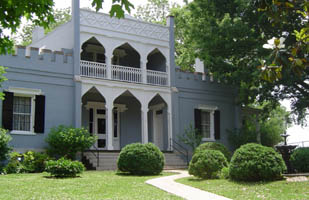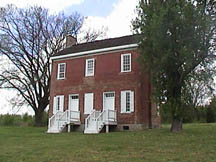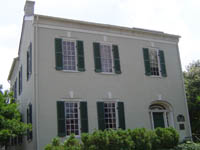Columbia, Tennessee: Historic
Sites and Events
>Home
>Community Introduction
<Previous
>Next
Antique Shops
Esther's Antiques
Helm's Jewelry
Sewell's Antiques
Steeley's Corner
Uptown Antiques
Westbury House
Antique Malls
Accents and Antiques of Columbia (931/380-8975)
Front Porch Antiques and Gifts (931/388-2545)
Sherry's Antique Mall (931/388-9806)
Athenaeum Rectory (located at 808 Athenaeum Street; 931/381-4822)
A Study of the Life of Franklin Gillette Smith
(used by permission)  (pdf file)
(pdf file)
A Thesis by Eva Pearl Quillen, Tennessee Technological University, June 1960.
History: "The Athenaeum Rectory was begun in 1835 by Nathan Vaught, Maury County's master builder, as a residence for Samuel Polk Walker, nephew of James K. Polk. Walker never lived there, however. The first occupant was the Reverend Franklin Gillette Smith who came to Columbia to be rector of The Columbia Female Institute, an Episcopal girls' finishing school.
"In 1852, Mr. Smith built his own girls' school, the Columbia Athenaeum, which became nationally known for its quality and breadth of curriculum. The school offered girls the same subjects that a well-educated young man would have pursued at that time, including physics, calculus, chemistry, and biology.
"The Athenaeum Rectory remained in the Smith family from 1837 to 1973 when Mr. Smith's granddaughter, Fannie Louise Davis, deeded the property to The Association for the Preservation of Tennessee Antiquities. It is listed in the National Registry of Historic Places.
Major Features: "The Moorish-Gothic Architecture of the facade of the Athenaeum Rectory is not typical of the general style in 1835. The colorful flashed glass around the front door, the original fountain on the front lawn, the chandelier that was originally a gasolier, and the wood-carpeting floors are all unusual features of the home. The beautiful 10-piece Meeks parlor suit belonged to Mrs. Smith's daughter by her first husband, another Mr. Smith. The small two-room building at the rear was built as a kitchen, but the Smiths never used it as such since they ate their meals with the girls at the school. The building now houses the office and museum store."
Photos of the Athenaeum Rectory
(Text used by permission of the Athenaeum.)
"The John Gordon House, located near the Duck River on the line adjoining Hickman and Maury Counties of Tennessee, was the home of Captain John Gordon. It was one of the first private brick dwellings within a 30-mile radius on the Natchez Trace. Captain Gordon was awarded large grants of land by the government in recognition of his services. On part of his land, near the Duck River, he built this home, reputed to have been one of the finest in the country.
"Captain Gordon, born in 1763 near Fredericksburg, Virginia, came to Nashville in approximately 1782. In 1793, he was commissioned by Governor Blount of Tennessee to be a captain of mounted infantry of the Davidson County regiment. In 1795, he was appointed a Justice of the Peace for Davidson County, and the next year was designated the first postmaster of Nashville. The captain had a distinguished record for conspicuous service during the Coldwater and Nickajack expeditions in 1787 and 1794. During the years 1790-95, Gordon defending the Cumberland Settlement against attack from hostile Creek and Cherokee Indians. In 1801-02, when the army was widening and clearing the Natchez Trace from Nashville to Natchez, Mississippi, Gordon made an agreement with the Chickasaw chief, George Colbert, to operate a trading post and ferry on the Duck River, near the site of the home Mrs. Gordon would begin in 1817. Sometime between 1808 and 1812, Gordon moved his family from Nashville to the Duck River (nearby Gordonsburg is named for John Gordon)."
(Text and photo used by permission of the Sons of Confederate Veterans.)
"The Elm Springs Mansion is a National Historic Landmark built in 1837 and is the international headquarters of the Sons of Confederate Veterans and Military Order of the Stars and Bars. It is fully furnished with period antiques, some of which are original to the home. Elm Springs is a Greek Revival mansion built by Maury County's master builder, Nathan Vaught. Situated on the old stage road that led from Pulaski to Franklin, Elm Springs witnessed the long marches of both the Confederate and Union Armies and served as the headquarters of Confederate General Frank E. Armstrong in November of 1864. It was the home of Colonel Abram Looney, a prominent local attorney who commanded the famous Company H Maury County Grays. Other attractions include the family cemetery and the Historic Elm Springs Gift Shop, which features a wide variety of Southern heritage items available nowhere else in the area."
(Text used by permission of the Sons of Confederate Veterans.)
Mule Day
"In Columbia, Tennessee, Mule Day has been a tradition since around 1840, when the first Monday in April brought huge crowds to the animal livestock show and The Mule Day Market (originally called Breeder's Day). Mules were such a big business in Maury County that the Columbia Mule Day had the distinction of being one of the largest livestock markets in the world.
"Mule Day, held on the first full weekend of April, unless that date is Easter (in which case it is moved forward one week to the second weekend of April) eventually evolved into what is now almost a week-long celebration of the mule. Thousands of visitors come to Columbia each year just to take part in the festivities. There are so many mules in one place on Mule Day that Columbia has long boasted the proud title of 'Mule Capital of the World.'"
Will Rogers was quoted as saying, "What the thoroughfare of Wall Street will do to you if you don't know a stock, Columbia will do to you if you don't know a mule."
(Text used from promotional materials about the event.)
"The Natchez Trace meanders through Maury County, of which Columbia is the county seat. Originally, the Trace was probably a series of Indian paths that slowly came to form a trail from Mississippi, over the low hills into the valley of Tennessee. As early as 1733, the French were familiar enough with the land to make a map that showed an Indian trail running from Natchez, Mississippi, to the Northeast. By 1785, settlers in the Ohio River Valley had established farms and began floating their crops down the rivers to Natchez or New Orleans in a search for markets. Returning home meant either riding horseback or walking, for the flatboats, too, were sold for their lumber, and the trail from Natchez was the most direct.
"As the numbers of boatmen grew, the crude trail was tramped into a clearly marked path. Over the years, improvements were made. By 1810, the Trace was an important wilderness road, the most heavily traveled in the Old Southwest. Many inns, locally called 'stands,' were built. By 1820, more than 20 stands were in operation along the Trace.
"Gangs of thieves created an element of danger, adding one more hazard in a catalog that included swamps, floods, disease-carrying insects and, sometimes, unfriendly Indians.
"A new chapter in transportation dawned in January 1812 when the steamboat New Orleans arrived in Natchez. Within a few years, steamboats were calling regularly at St. Louis, Nashville, and Louisville. Travelers liked the speed and comparative safety of steamboat travel more than the slow pace of going over land. Soon, the bustle of the Trace had quieted to the peacefulness of a forest lane."
(Text used from promotional materials about the site.)
"The 1816 home is the only surviving residence of the eleventh president other than the White House. Original furnishings are from President and Mrs. Polk's years in Tennessee and Washington D.C. It features the Sisters' House museum and formal gardens with the original Polk fountain."
More Photos of the James K. Polk Home
(Text used by permission of the Antebellum Trail Organization.)


